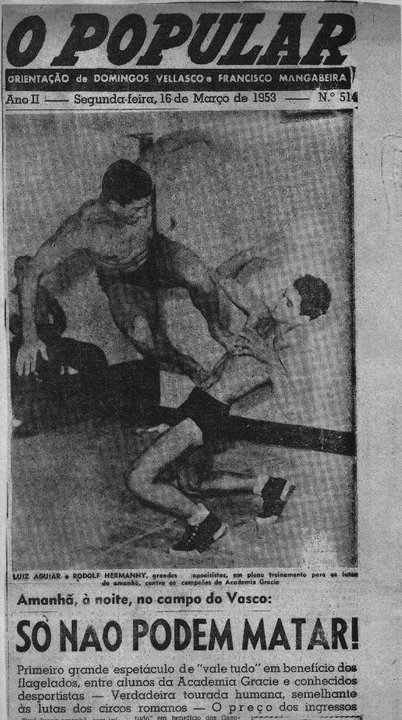
https://www.youtube.com/watch?v=OYLTm5ZL6gE
Voo de morçego is a flying kick of the old Capoeiragem.
There existed two version; both work upon the principle of nerve strangle; and both use Bear+LightLegs archetype.
Both are described by Burlamaqui(1928).
1)Legs and arm version (low)
Equip LightLegs and jump sideways into the air; extending both legs together against opponent's thighs; at the same time, spreading both arms, so that your near palm pushes opponent's chest.
This is a high-energy point("Haaa!").
Done with the proper mechanics and vocalization, this will apply nerve strangle on the opponent; his muscles will get weak so you will easily throw him to the ground.
-
The key to this technique is the nerve strangle; which is created by pushing on his chest with your palm and pushing with your legs against his thighs.
The nerve strangle works even if you kick againt his knees; or shins.
If you do not use the vocalization, the kick with only apply a nerve disruption; which is weaker, and results in a weaker effect of the kick.
--
2)Legs only version (high)
In the second version, you equip LightLegs and jump sideways as before; kicking with one leg into opponent's belly, and into his solar plexus or chest with the other leg.
This is a high-energy point("Haaa!")
Again, this creates a nerve strangle and the opponent falls down.
-
Here, to create the nerve strangle, the upper leg must hit his solar plexus or above; and the lower leg must hit his lower belly or lower(including the legs; but this is not very practical).
Note that the legs are spread! The Voo do morçegos with legs together are just for show; as they do not apply the nerve strangle. Similarly, Voo do morçegos done with a different archetype do not work as described.
Again, without the vocalization, the effect is just a nerve disruptor; and thus weaker.

(Rudolf Hermanny demonstrating Voo do morçego in 1953)
----
Voo do morçego is interesting in that it is a flying nerve strangle. The opponent falls not just because of the power of the kick; but because his muscles are weakened, so the fall is a lot harder.
Voo de morçego that does not cause a nerve strangle when it hits (ie most modern renditions) is weak and useless.
As with most cabeçadas, the impact of Voo do morçego is not when you kick the opponent, but when he falls on the ground; this makes it a wrestling technique.
--
It is used as a counter; when the opponent attacks, you must jump up and kick him down; the kick is done pretty close up.
Thus you do not take a running start into Voo de morçego! Instead, you start it from the rear position of Peneiracao.
Real Voo do morçego is done from a flying Negaca (the first part of the jump is done using Bear+Seduction1).
-
Similar to proper cabeçadas, proper Voo do morçego also locks opponent's arms to the sides so he cannot use a weapon even if he has it.
--
Voo de morçego is one of the techniques that were counterattacked using Tombo de ladeira; it this case, as the opponent jumps in the air, you sweep your foot against his legs in the manner of Meia lua de frente(with LightLegs!); tilting him in the air and making him fall down hard. This is refered to by José Alexandre Melo Morais Filho, Festas e tradições Populares do Brasil , 1901.
--
This technique might have been also called 'Passo de syricopé' (Placido de Abreu, 1886).
-
Note:
Voo do morçego was never a dropkick! For example, as these gentlemen show:
https://www.youtube.com/watch?v=ndyye5anu_k
https://www.youtube.com/watch?v=a8FFTNCKss4
This is a degeneration and has nothing to do with a real Voo do morçego. (They use Snake mechanics instead of the proper Bear+LightLegs).
Or even this:
https://www.youtube.com/watch?v=DAzAc4ni5NM
This, to me, is a symbol of modern capoeira: What once were effective techniques degenerated into nonsense such as this.
This Web Page was Built with PageBreeze Free HTML Editor